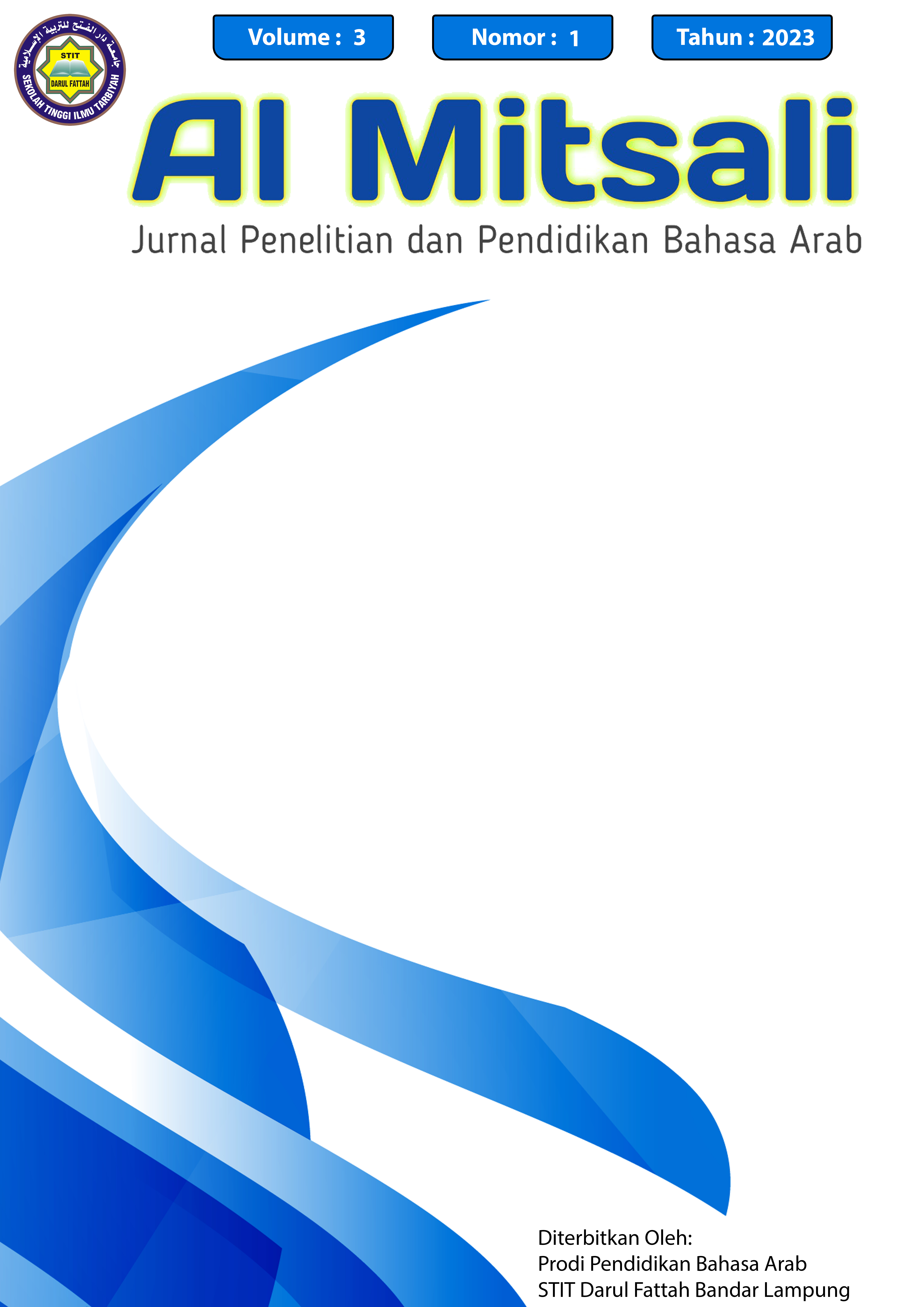Analisis Kontrastif Isim Dhomir Dalam Bahasa Arab Dan Kata Ganti Dalam Bahasa Indonesia Serta Langkah-Langkah Pembelajarannya
Abstract
The background of this research is due to the contrast between the isim dhomir in Arabic and pronouns in Indonesian which may cause errors and difficulties in learning Arabic. In this research, the researcher examines the contrastive analysis between the isim dhomir in Arabic and pronouns in Indonesian accompanied by an explanation of the steps for learning the isim dhomir. This research includes library research using contrastive and descriptive analysis to analyze the data. Broadly speaking, the findings through contrastive analysis include: 1) In B1 (first language: Arabic) accommodates different forms of pronouns that are used to replace the subject with pronouns to replace objects and signs of ownership, while in B2 (second language: Indonesian) the form of pronouns can be used in all circumstances , both subject, object and, sign of ownership. 2) In B1 it accommodates gender differences, while in B2 it doesn’t. 3) B1 and B2 have the same rules, namely: the placement of the pronoun that functions as an object is after the verb and the pronoun that functions as a sign of ownership is after the noun. The appropriate learning steps to be applied use the qowaid wa al-tarjamah learning steps.
References
Abdurochman. 2017. Bahasa Arab dan Metodelogi Pembelajarannya. AURA, CV. Anugerah Utama Raharja: Bandar Lampung.
Abdul Chair. 2019. Tata Bahasa Praktis Bahasa Indonesia. Redika Cipta: Jakarta.
Abdullah Ibnu Hamid. Silsilah Ta’lim Lughatul Al-Arabiyah Mustawa Tsani (Sharf).
Lembaga Dakwah dan Taklim: Jakarta.
____________________ Silsilah Ta’lim Lughatul Al-Arabiyah Mustawa Tsani (Nahwu).
Lembaga Dakwah dan Taklim: Jakarta.
Acep Hermawan. Metodologi Pembelajaran Bahasa Arab. PT Remaja Rosdakarya: Bandung.
Ahmad Fuad Effendy. 2012. Metodologi Pengajaran Bahasa Arab. Misykat: Malang.
A. Shohib Khaironi. 2008 Audloh Al-Minhaj Fi Mu’jam Qowaid Al-Lughah Al-Arabiyah. WCM Press: Jakarta.
A. Zakaria. 2020. Ilmu Nahwu Praktis Sistem Belajar 40 Jam. ibn azka press: Tarogong Garut.
Farida Nugrahani. 2014. Metode Penelitian Kualitatif dalam Penelitian Pendidikan Bahasa. Surakarta.
Fuad Ni’mah. tanpa tahun. Mulakhos Qowa’id Al-Lughah Al-Arabiyah. Dar AlTsaqofah Al-Islamiyah: Beirut.
Harimurti Kridalaksana. 2018. Kelas Kata Edisi Kedua. PT Gramedia Pustaka Utama: Jakarta.
Hasan Alwi, dkk. 2010. Tata Bahasa Baku Bahasa Indonesia Edisi Ketiga. Balai Pustaka: Pusat Bahasa Dapartemen Pendidikan Nasional.
Hery Guntur Tarigan. 2009. Pengajaran Analisis Kontrastif Bahasa. Angkasa: Bandung.
Leni Syafyahya. Tanpa tahun. Kuasa Masyarakat Atas Bahasa. Lembaga Pengembangan
Teknologi Informasi dan Komunikasi (LPTIK) Universitas Andalas. Padang,
Sumatera Barat.
Lexy J.Moleong. 2017. Metode Penelitian Kualitatif. PT Remaja Rosdakarya: Bandung
Moch Anwar. 2020. Ilmu Nahwu Terjemah Matan Al-Jurumiah dan Imrithy. Sinar Biru Algesindo: Bandung.
M. Subhana. 2001. Dasar-Dasar Penelitian Ilmiah. Pustaka Setia: Bandung.
S. Efendi. 2020. Tata Bahasa Dasar Bahasa Indonesia. PT. Remaja Rosdakarya: Bandung.
Sugiyono. 2015. Metode Penelitian Pendidikan Pendekatan Kuantitatif, Kualitatif, dan R&D. Alfabeta: Bandung.
Surastina, Effrina & Singgih. 2019. Pengantar Bahasa Indonesia. Yogyakarta: Elmatera












